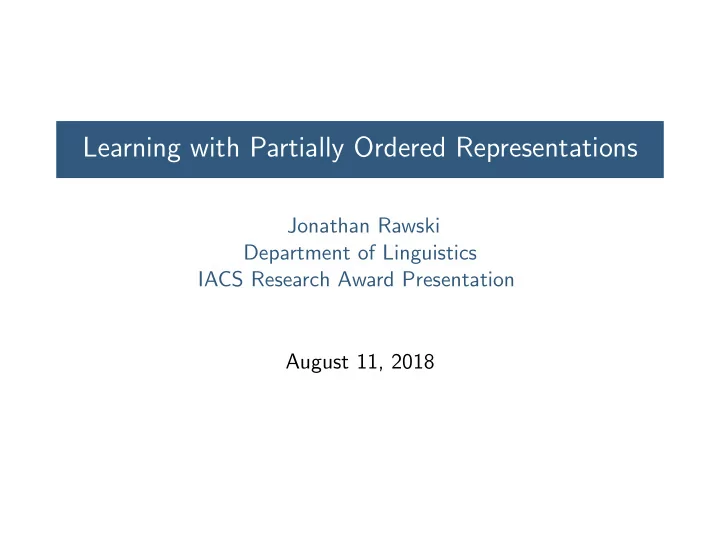

Learning with Partially Ordered Representations Jonathan Rawski Department of Linguistics IACS Research Award Presentation August 11, 2018
The Main Idea Learning is eased when attributes of elements of sequences structure the space of hypotheses 1
2
Poverty of the Stimulus and Data Sparsity Number of English words: ∼ 10,000 Possible English 2-grams: N 2 Possible English 3-grams: N 3 Possible English 4-grams: N 4 ... easy learning if normal distribution 3
Poverty of the Stimulus and Data Sparsity BUT: In the million-word Brown corpus of English: 45% of words, 80% of 2-grams 95% of 3-grams appear EXACTLY ONCE Bad for learning: Huge long-tailed distribution How can a machine know that new sentences like “nine and a half turtles yodeled” is good? “turtles half nine a the yodeled” is bad? 4
Poverty of the Stimulus and Data Sparsity BUT: In the million-word Brown corpus of English: 45% of words, 80% of 2-grams 95% of 3-grams appear EXACTLY ONCE Bad for learning: Huge long-tailed distribution How can a machine know that new sentences like “nine and a half turtles yodeled” is good? “turtles half nine a the yodeled” is bad? 4
The Zipf Problem 5
The Zipf Problem 5
Zipf Emerges from Latent Features 6
Zipf Emerges from Latent Features 6
Zipf Emerges from Latent Features 6
7
8
Learning Algorithm (Chandlee et al 2018) What have we done so far? ◮ Provably correct relational learning algorithm ◮ Prunes Hypothesis space according to ordering relation ◮ Provably identifies correct constraints for sequential data ◮ Uses data sparsity to its advantage! Collaborative work with: Jane Chandlee Jeff Heinz Adam Jardine (Haverford) (SBU) (Rutgers) 9
Bottom-Up Learning Algorithm 10
Example: Features in Linguistics sing ring bling ng = [+Nasal,+Voice,+Velar] 11
Example: Features in Linguistics sand sit cats s= [-Nasal, -Voice , - Velar ] 12
Structuring the Hypothesis Space: Feature Matrix Ideals Feature Inventory ◮ ± N = Nasal ◮ ± V = Voiced ◮ ± C = Consonant Example * [-N,+V,+C] � * [-N,+V] [-N,+C] � [-N] 13
Structuring the Hypothesis Space: Feature Matrix Ideals Feature Inventory ◮ ± N = Nasal ◮ ± V = Voiced ◮ ± C = Consonant Example * [-N,+V,+C] � * [-N,+V] [-N,+C] � [-N] 13
Example +N +N +N +N -N -N -N -N +V +V -V -V +V +V -V -V +C -C +C -C +C -C +C -C +N +N +N +N -N -N -N -N +V +V -V -V +V -V +C -C +V -V +C -C +C -C +C -C +N -N +V -V +C -C 14
Example +N +N +N +N -N -N -N -N +V +V -V -V +V +V -V -V +C -C +C -C +C -C +C -C +N +N +N +N -N -N -N -N +V +V -V -V +V -V +C -C +V -V +C -C +C -C +C -C +N -N +V -V +C -C 15
Example +N +N +N +N -N -N -N -N +V +V -V -V +V +V -V -V +C -C +C -C +C -C +C -C +N +N +N +N -N -N -N -N +V +V -V -V +V -V +C -C +V -V +C -C +C -C +C -C +N -N +V -V +C -C 16
Example +N +N +N +N -N -N -N -N +V +V -V -V +V +V -V -V +C -C +C -C +C -C +C -C +N +N +N +N -N -N -N -N +V +V -V -V +V -V +C -C +V -V +C -C +C -C +C -C +N -N +V -V +C -C 17
Two Ways to Explore the Space Top-Down Induction ◮ Start at the most specific points (highest) in the semilattice ◮ Remove all the substructures from the lattice that are present in the data. ◮ Collect the most general substructures remaining. Bottom-Up Induction ◮ Beginning at the lowest element in the semilattice, ◮ Check whether this structure is present in the input data. ◮ If so, move up the lattice, either to a point with an adjacent underspecified segment, or a feature extension of a current segment, and repeat. 18
Semilattice Explosion voc cor cor obs low obs son nas vls bac nas vls 1 2 1 2 3 S NT S ant 19
Semilattice Explosion voc cor cor obs low obs son nas vls bac nas vls 1 2 1 2 3 S NT S ant 19
Plan of the project What has been done Provably correct bottom-up learning algorithm Goals of the Project ◮ Model Efficiency ◮ Model Implementation ◮ Model Testing - large linguistic datasets ◮ Model Comparison: UCLA Maximum Entropy Learner Broader Impacts ◮ Learner that takes advantage of data sparsity ◮ applicable on any sequential data (language, genetics, robotic planning, etc.) ◮ implemented, open-source code 20
Project Timeline 2018-2019 Month Plan September Algorithmic Efficiency October Implement string-to-model functions in Haskell November Implement top-down learner in Python3 December Implement bottom-up learner in Python3 January Febuary test learning algorithm - Brazilian Quechua corpus March April Model Comparison with May Maximum Entropy Learner & Deep Networks Extend from learning patterns to transformations test on other linguistic sequence data (syntax) future work extend to other non-linguistic sequences extend to robotic planning 21
The Main Idea Learning is eased when attributes of elements of sequences structure the space of hypotheses Lila Gleitman (1990) ”the trouble is that an observer who notices everything can learn nothing , for there is no end of categories known and constructable to describe a situation” 22
Recommend
More recommend